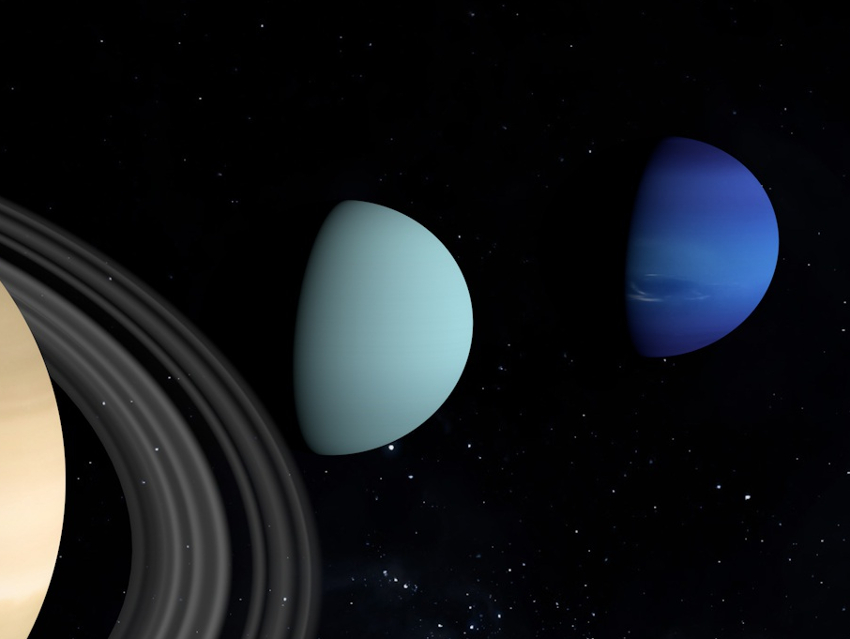Planetary Chemistry of the Ice Giants
Astronomers have watched the outer ice giants of our solar system, Uranus and Neptune, with intrigue for decades. The fundamentals of spectroscopy and other observations have always held that their gaseous atmospheres are composed purely of helium. A study by Xianlong Wang, Institute of Solid State Physics, Chinese Academy of Sciences, Hefei, Yinwei Li, Jiangsu Normal University, Xuzhou, China, and colleagues opens up the possibility that the upper mantle contains exotic compounds of helium and ammonia that can only form and persist under the incredible pressures present there.
If we can understand the chemistry of the planets, we might be able to gain new insights into their formation and evolution. We can study our own planet first-hand, but even then the deep interior is off-limits to direct analysis—and the interiors of the distant ice giants of the solar system even more so. Conventionally, we can understand them only through astronomical observation and measurements of their gravitational and magnetic effects. On this basis, we believe that both of these planets have a triple-layered structure: a rocky core, an ice mantle (sub-divided into a lower and an upper mantle), and a gaseous atmosphere. Indirect analysis suggests that the chemistry of the upper mantle is a mixture of ionized water, ammonia, and methane. The lower mantle at much higher pressures is thought to comprise metallic water, ammonia, and methane.
Several research teams have simulated the behavior of the chemical compounds in the mantles of the ice giants within large pressure and temperature ranges—30 to 300 GPa and 300 to 7,000 K, respectively. Various superionic phases have been hypothesized, as well as the dissociation and re-assembly of methane into other hydrocarbons. In superionic water, for example, water molecules break apart and the oxygen ions form an evenly spaced lattice while the hydrogen ions move freely within the oxygen lattice.
Helium did not even enter the equations in this earlier work; it was assumed that the gas would be present only in the atmosphere and not the icy mantles. However, other simulations have suggested that helium might be able to form stable species under extreme pressures, and unusual compounds of helium with sodium, iron, magnesium, water, and iron(IV) oxide have been posited.
Helium under Pressure
The researchers wanted to see whether helium might also form compounds under pressure with ammonia. They have carried out structure predictions that revealed two energetically stable compounds of helium and ammonia. One contains a 1:1 ratio of ammonia to helium, the other a 2:1 ratio.
The team explains that at low temperature, the (NH3)2He structure is ionic and the ammonia molecules dissociate partially into NH2− and NH4+ ions. At 100 GPa and 1,000 K, the same compound forms an intermediate phase in which the hydrogen atoms vibrate around the nitrogen atoms. At about 2,000 K, a superionic phase would be seen, with the hydrogen and helium atoms behaving like liquids within a fixed nitrogen sub-lattice. Finally, when the temperature reaches 3,000 K, the system enters a fluid phase.
“Our results show that He can react with NH3 to form (NH3)2He under extreme conditions, to a certain extent corresponding to the upper mantles of Uranus and Neptune, thereby providing information essential to the understanding of the interior models of these planets,” the team says.
“In this work, we studied only the possibility of the formation of stable compounds of helium and ammonia”, Li told ChemistryViews. “The results provide evidence that helium could be trapped inside the ice giants in the form of compounds with ammonia.” He adds that the next step will be to investigate whether helium can form stable compounds with the other two main components, methane and water. There is also the possibility of considering the high pressures and temperatures within the gas giant Jupiter—they can reach 4,000 GPa and 20,000 K, respectively. “We also would like to examine whether helium could form stable compounds with dihydrogen at such extreme conditions,” Li added.
- Formation of ammonia–helium compounds at high pressure,
Jingming Shi, Wenwen Cui, Jian Hao, Meiling Xu, Xianlong Wang, Yinwei Li,
Nat. Commun. 2020.
https://doi.org/10.1038/s41467-020-16835-z




